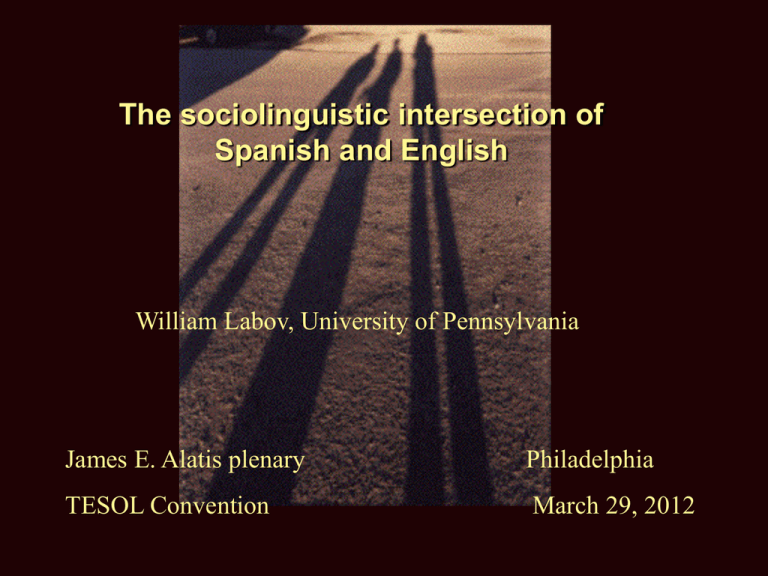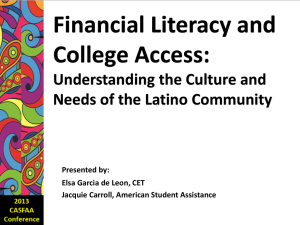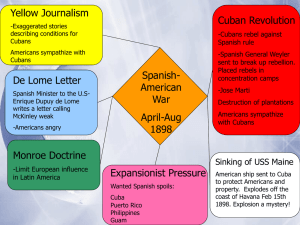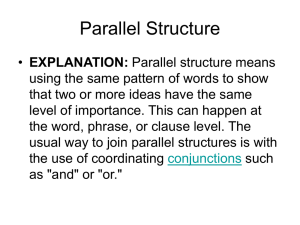The sociolinguistic intersection of Spanish and English.
advertisement

The sociolinguistic intersection of
Spanish and English
William Labov, University of Pennsylvania
James E. Alatis plenary
Philadelphia
TESOL Convention
March 29, 2012
The program
1. The sociolinguistic dimensions of dialect shifting:
black/white/Latino
2. Effects of learning to read in Spanish first
a. The (sh/ch) variable: a superficial substrate
effect
b. The possessive: effects of dialect differences
c. The soft-c rule: greater use of the alphabet
The sociolinguistic intersection of
Spanish and English
S. Poplack. Dialect Acquisition among Puerto Rican bilinguals
Careful
[əɪ]
Casual
Careful
Casual
[a:]
Language in Society 7:89-103, 1978
S. Poplack. Dialect Acquisition among Puerto Rican bilinguals
Careful
[əɪ]
Casual
Careful
Casual
[a:]
Language in Society 7:89-103, 1978
Sociometric diagram of sixth grade at St. Veronica’s
1. The sociolinguistic dimensions of dialect shifting:
black/white/Latino
2. Effects of learning to read in Spanish first
a. The (sh/ch) variable: a superficial substrate
effect
b. The possessive: effects of dialect differences
c. The soft-c rule: greater use of the alphabet
Are there significant differences in reading error
profiles to be found among different ethnic
groups with different language backgrounds?
If so,
are different strategies needed to
improve the teaching of reading to
members of those groups?
from the contrastive analysis of Spanish and English
Spanish [tʃ] = [ʃ]
mucho
che
English [tʃ] ≠ [ʃ]
chip ≠ ship
The reading research program
Number of subjects by language/ethnic group and geographic
region for the year 2003-2004 (N=246)
Language/ethnic group
in Phila in Calif
Total
African American
19
33
52
Caucasian
40
17
57
Latino Spanish readers
37
37
74
Latino English readers
37
26
63
Total:_____________________133_______ 113_____ 246
Diagnostic
readings at
Park School,
Philadelphia
The cat took one bite and let out a wail.
Ray said, "Darn, those chips are stale!
It's a shame that you went and bought them on sale.
They taste like the food that's served in a jail."
ch_ and sh_ words in the diagnostic reading Ray and His Cat Come Back
Ray grabbed Matt’s chips
..those chips are stale…
The cat spit out the chips. . .
Matt didn’t reach up to Ray’s chin
I don’t choose to listen…
. . .tried not to shake.
It’s a shame that. . .
Now I’m going to show you. . .
His teeth are as sharp as the edge of a knife . .
Errors with initial sh- ch- for 109 Philadelphia African-Americans
chips
[3]
cheer
cheer
cheers
cheese
cheese
chest
children
children
children
children
children
children
children
chip
chip
chip
chip
chip
chip
chip
chip
chippies
chirpings
chosing
church
church
chin
ch-cha
chain
chain
chair
chairs
chan
cheer
chic
chine
chip
chips
chips
chips
chipsh
choose
ch-chase
chase
cheat
chees
cheese
cheese
cheese
cheese
chew-s
chose
chose
chrose
chuss
shame
shake
show
sharp
sham
sham
sham
sharing
shim
shim
shimmy
shlame
shom +
short
sh-shack +
shick
short +
shrayke
shuck +
sh-shock
shoe
shop
short
shop
shape
shape
shape
shape
sharpy
shop
shpore
shrop
xxx grammatical errors
sh_ ch_ errors for 51 Philadelphia Latinos who learned to read in Spanish first
chips
[3]
ch-cheapess
cheeps
chip
chip
chip
chip
chip
chip
chip
chip
chip
chip
chip
chup
sheese
ship
ship
ship
ship
ship
ships
ships
ships
ships
ships
ships
ships
ships
ships
chin
choose
shame
shake
show
sharp
ch-cheen
cheen
cheen
chic
chine +
chins
chip +
sheen
shin
shin
shin
shin
shin
ch-chalks
chew
chinsen
choice
choise
choise
chose
chose
chose
chose
chose
chose
chose
chose
chosey
choss
shoes
shoort
shoose
shoose
shows
shows
chame
chame
shamuh
shay
shem
shem+
shime
shirm
shome
chair
shack
shack
shack
shack +
sheck
shock
chow
shah
shahw
shar
shoes
shout
shap
shar
shar+
sharpt
shblatt
xxx
xxx
xxx
xxx
grammatical error
sh/ch alternation
/i/ -> /iy/
grammatical & phonological
ch_ reading errors per student by ethnicity, language and region
1.4
1.2
1
0.8
California
0.6
Philadelphia
0.4
0.2
0
EuroAmerican
AfricanAmerican
Latino
(Eng)
Latino
(Span)
Spanish language influence on reading of English
1
Proportion of deaffrication errors
(chips -> ships)
0.8
0.6
California
Philadelphia
0.4
0.2
0
EuroAmerican
AfricanAmerican
Latino (Eng) Latino (Span)
1
Proportion of /i/tensing errors
(chips -> cheaps)
0.8
0.6
California
Philadelphia
0.4
0.2
0
EuroAmerican
AfricanAmerican
Latino (Eng) Latino (Span)
Proportion of ch -> sh errors, before and after intervention
0.5
0.4
California-pre
0.3
California-post
Philadelphia-pre
0.2
Philadelphia-post
0.1
0
Euro-American
African-American
Latino(Eng)
Latino(Span)
Proportion of de-affrication errors that are the only errors in the word
1
0.8
0.6
California
Philadelphia
0.4
0.2
0
EuroAmerican
AfricanAmerican
Latino (Eng) Latino (Span)
In responding to oral reading, we must distinguish
between differences in pronunciation and mistakes
in reading.
How can we do this?
Absence of –ed in oral reading: Janal M., 7
stepped
jump
The cat spit out the chips and jumped in Ray’s coat
True
error
Potential
error
Absence of verbal /s/ in oral reading: Jason P., age 7
Hey Black doesn’t eat cats, not even one
like grow
which
He just likes to growl and watch them run.
Potential
error
True
error
True
error
How to determine whether a potential error is a true
error in the decoding of the text
The Semantic Shadow Hypothesis: An error in the
identification of a given word increases the probability of
errors in the decoding of the following text.
A potential error type has a significant probability of being a
true reading error if the rate of following errors is
significantly greater than the rate for correct readings.
W. Labov & B. Baker. What is a reading error?
Applied Psycholinguistics 31:735-757.
Frequency of following errors for clear errors and correct reading by dialect type
0.35
0.30
0.25
0.20
Clear errors
Correct
0.15
0.10
0.05
br
_
sh
_
ch
_
ra
co
l
pu
la
Ir
{s
re
}
gu
la
r
pa
st
pl
u
{s
{e
}
d}
cl
us
te
ot
r
he
r
{e
d}
es
si
ve
l{
s}
Po
ss
Ve
rb
a
_C
C1
0.00
Frequency of following errors for clear errors, potential errors and
correct reading by dialect type [N=567]
0.35
0.30
0.25
Clear errors
Potential errors
Correct
0.20
0.15
0.10
0.05
br_
sh_
ch_
Irregular
past
copula {s}
plural
other {ed}
{ed}cluster
Possessive
{s}
Verbal {s}
_CC1
0.00
Frequency of following errors for clear errors, potential errors and correct
readings by dialect type for African American and Latino (S) readers [N=238]
0.40
0.35
0.30
0.25
Errors (AA)
Pot errors (AA)
Correct (AA)
0.20
Errors (S)
Pot errors (S)
Correct (S)
0.15
0.10
0.05
br ~ b
ch_->sh
Irregular past
sneaked /snuck
Potential errors
Copula {s}
Plural {s}
Possessive {s}
Verbal {s}
other {ed}
{ed} cluster
Heterovoiced
_CC
Homovoiced
_CC
0.00
Relation of morphosyntactic zeroes to correct readings and clear errors
from frequencies of following errors.
C= correct readings; X = potential errors; E = clear errors.
African-American
C≠X≠E
Latino(Spanish)
C≠X=E
Possessive –s
C≠X≠E
C≠X=E
Copula –s
C≠X≠E
C≠X=E
Past tense –ed
C=X≠E
C≠X≠E
Verbal -s
1. The sociolinguistic dimensions of dialect shifting:
black/white/Latino
2. Effects of learning to read in Spanish first
a. The (sh/ch) variable: a superficial substrate
effect
b. The possessive: effects of dialect differences
c. The soft-c rule: greater use of the alphabet
The bilingualism of possession
Tonya Wolford. Variation in the expression of
possession by Latino children.
Language Variation and Change 18: 1-13.
Margarita M., 8, California: well there's two men alive
and one woman alive -- and . . . . . . and -- and the
other -- the brother of the other woman has a book
and he reads iT. . . . and -- and the man comes to life
Tutor. . . . Do you ever get to baby-sit her?
Mark S., 7, Philadelphia. Yeah. Sometimes.
At my cousinz house. z
Tutor. Can you tell me the story?
Carlos L., 9, Philadelphia: He's a killer and he
try to - ah - the -- he kills people and then he
cuts in -- in people bodies
1. The sociolinguistic dimensions of dialect shifting:
black/white/Latino
2. Effects of learning to read in Spanish first
a. The (sh/ch) variable: a superficial substrate
effect
b. The possessive: effects of dialect differences
c. The soft-c rule: greater use of the alphabet
The soft-c rule
(orthographic)
The letter “c” is pronounced as
/s/ before the letters /i, e, y/ elsewhere, as /k/.
English
Spanish
city
cent
icy
cielo
Cebuano
call
cot
cute
cantar con
Exceptions:
Celtics cepstrum
none
Cuba
Soft-c words in the diagnostic reading Ray and His Cat Come Back
On Friday, I was in Aunt Cindy's store,
And Ray was with the same old cat that I saw before
I pulled out of my pocket a rusty old dime.
I said, "Go spend it, cat, if you've got the time."
Ray stared at me and said, "Ten cents?
You really think that I am that dense?”
When I got to two, Ray and his cat ran.
Ray certainly fell for my new cat plan.
Soft-c errors of 109 Philadelphia African-American readers
Cindy’s
Cindy
cindy
candia's
candies
candily's
candy
Candy
Candy
candy
candy
candy
candy
candy
candy's
candy's
candy's
Candy's
Candy's
candy's
candy's
candy's
candy's
candy's
candy's
candy's
candy's
candy's
card
Carry's
charl
chatee
cindy
cities
clan's
collie's
condy's
condy's
cried
crying's
cryme's
c's
dk
dk
dk
dk
dk
dk
dk
dk
dk
dk
dk
dk
dk
dk
dk
dk
dk
cents
dk
dk
dk
dk
dk
dk
dk
dk
kkkala
kare-de
kate
kendy'
kenny's
kiddy's
kindy's
Kindy's
kindy's
kins
sally
seal +
sender
story
why
can
can
cans
cans
can't
cants+
cat
cat
cats
cats
cats
cats
cent
cent
cent
cent
ceret
close
coats
coin
coin
coin
coins
coins
coins
coins
coins
coins
coins
coins
coins
coins
coins
coins
coins
coins
coins
coins +
come
counts
counts
counts
coy
dk
dime
dk
dk
dk
dk
dk
dk
dk
dk
dk
dk
dk
dk
dk
certainly
dk
dk
dk
dk
dk
dk
dk
k- +
kenny
kents
kents
kents +
kets
kits
kittens
kittens
sent
tets
your+
are
called
came
cant
care
carefully
carried
cart
cartenly
casidell
cat
caught
cayrent
cert
clearly
clearly
continue
cota
could
couldn't
couldn't
couldn't
counted
cracked
crackilly
crah
cried
cried
cried
crut
curtail
curtain
dk
dk
dk
dk
dk
dk
dk
dk
dk
dk
dk
dk
dk
dk
dk
dk
dk
dk
dk
dk
dk
dk
dk
dk
dk
dk
dk
dk
dk
dk
dk
feel
for
fount
itches
kkangily
kartimitly
kaynly
k-cera
kelly
kert
over
quite
reach
said
scared him
scored him
screwed
sentiny
seriously
ser-really
suntalaly
Soft-c errors of 109 Philadelphia Latinos who learned to read in Spanish first
Cindy's
cindy
cindy
cindy
cindy
cindy
cindy
candy
children
cidy
cind
cindy
cindy
cindy
cindy +
cindy+
city
city
city
cleande
dk
dk
dk
dk
dk
kin
kin din
kindy
sseat
see
sid
sidi's
sidy
sindings
sin's
sunday's
sunday's
cents
cant
cecenents
cent
cent
center
cert
dk
dk
dk
dk
kent
kets
sen
sense
sent
sent
sets+
certainly
cair-than
candily
carefully
centainly
centerly
certain-olly
cert-aint-ly
certaynly
cer-ten-in-lee
certully
certully
cet-lonely
dk
dk
dk
dk
kar
kertenn
reclinely
ssaid
sair-ten-lee
san+
sardtangent
sayree
say-ur-tenly
scratchly
searched
senentenly
sentree
sentrin
seranly
sernly
sert+
set
set
sintanely
sirtenly
st
startlet
don’t know
African Americans:
79
Latinos who learned to read in English first:
14
Soft-c reading of Cindy’s, cents, certainly
1
0.9
0.8
0.7
0.6
Proportion error
0.5
Soft-c reading
0.4
0.3
0.2
0.1
0
White
(Phila)
White (Cal)
AfricanAmerican
(Phila)
African- Latino-Eng Latino-Eng Latino-Span Latino-Span
American
(Phila)
(Cal)
(Phila)
(Cal)
(Cal)
Soft-c and hard-c reading by ethnic group, language and region
100%
90%
80%
70%
60%
Don't know
50%
Hard-C
40%
Soft-C
30%
20%
10%
0%
White
(Phila)
White (Cal)
AfricanAmerican
(Phila)
AfricanAmerican
(Cal)
Latino-Eng
(Phila)
Latino-Eng Latino-Span Latino-Span
(Cal)
(Phila)
(Cal)
The soft-c rule
(phonological)
In Spanish, the letter “c” is pronounced as
/s/ before the non-low front vowels
/i. e / cielo
/k/. elsewhere
Cebuano
este
The soft-c rule
(phonological)
In Engllsh, the letter “c” is pronounced as
/s/ before the non-low front vowels /i, iy, e/
city
decease
cent
and before the low central nucleus
/ay/ cycle decide incisor
/k/. elsewhere
,
Regression analysis of soft-C reading scores
Pretest
Post-pretest
African-American
n.s.
n.s.
Latino (English)
-.10*
-.12*
Latino (Spanish)
.37***
.24***
California
.08*
n.s.
Female
,09**
n.s.
100% correct = 1.0, 100% wrong = 0.0
Regression analysis of possessive reading scores
Pretest
Post-pretest
African-American
n.s.
n.s.
Latino (English)
-.09*
n.s.
Latino (Spanish)
n.s.
n.s.
California
.07**
.05*.
Female
n.s.
n.s.
100% correct = 1.0, 100% wrong = 0.0
Three linguistic consequences of learning to read
in Spanish first
1. The merger of the ch- and sh- word classes has no
direct consequences for reading or comprehension.
2. The immediate grasp of the soft-c rule reflects a
greater tendency to use alphabetic combinations in
decoding.
3. Use of the periphrastic possessive gives more
support to understanding the possessive inflection
than the use of the zero attributive form.
www.ling.upenn.edu/labov










